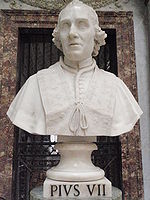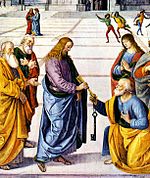- Pope Pius VII
-
Pius VII 
Portrait by Jacques-Louis DavidPapacy began 14 March 1800 Papacy ended 20 August 1823
(23 years, 159 days)Predecessor Pius VI Successor Leo XII Orders Ordination 21 September 1765 Consecration 21 December 1782
by Francesco Saverio de ZeladaCreated Cardinal 14 February 1785 Personal details Birth name Barnaba
Niccolò Maria Luigi ChiaramontiBorn 14 August 1742
Cesena, Papal StateDied 20 August 1823 (aged 81)
Rome, Papal StateOther Popes named Pius Pope Pius VII (14 August 1742 – 20 August 1823), born Barnaba Niccolò Maria Luigi Chiaramonti, was a monk, theologian and bishop, who reigned as Pope from 14 March 1800 to 20 August 1823.
Contents
Early life
Chiaramonti was born at Cesena, the son of Count Scipione Chiaramonti; his mother, Giovanna, was the daughter of the Marquess Ghini and was related to the Braschi family. He joined the Benedictine Order in 1756 at the Abbey of St Maria del Monte of Cesena, where he received the monastic name Gregory. He then became a teacher at Benedictine colleges in Parma and Rome. He was ordained to the priesthood on 21 September 1765.
His career became a series of promotions following the election of his relative, Giovanni Angelo Braschi, as Pope Pius VI (1775–99). In 1776 Pius VI appointed the 34-year old Dom Gregory, who had been teaching at the Monastery of Sant'Anselmo in Rome, as honorary abbot in commendam of his monastery. Though this was an ancient practice, this drew complaints from the monks of the community, as monastic communities generally felt it was not in keeping with the Rule of St. Benedict. In December 1782 the pope appointed Dom Gregory as the Bishop of Tivoli, near Rome. Pius VI soon named him, in February 1785, simultaneously both as a Cardinal-Priest, with his titular church being the Basilica of St. Callistus[1], and as the Bishop of Imola, an office he held until 1816.[2]
When the French Revolutionary Army invaded Italy in 1797, Cardinal Chiaramonti cautioned temperance and submission to the Cisalpine Republic they established. In his Christmas homily that year, he asserted that there was no opposition between a democratic form of government and being a good Catholic: "Christian virtue makes men good democrats.... Equality is not an idea of philosophers but of Christ...and do not believe that the Catholic religion is against democracy," said the bishop.[3]
Papacy
Papal styles of
Pope Pius VII
Reference style His Holiness Spoken style Your Holiness Religious style Holy Father Posthumous style None Election
Following the death of Pius VI, by then virtually France's prisoner, at Valence in August 1799, the conclave to elect his successor met on 30 November 1799 in the Benedictine Monastery of San Giorgio in Venice. There were three main candidates, two of whom proved to be unacceptable to the Habsburgs, whose candidate, Alessandro Mattei, could not secure sufficient votes. After several months of stalemate, on 14 March 1800, Chiaramonti was elected as a compromise candidate, certainly not the choice of die-hard opponents of the French Revolution, and took the name of Pius VII.[3] He was crowned on 21 March, in a rather unusual ceremony, wearing a papier-mâché papal tiara, since the French had seized the original along with Pius VI. He then left for Rome, sailing on a barely-seaworthy Austrian ship, the "Bellona", which did not even have cooking facilities. The voyage took 12 days to carry him to Pesaro, from where he proceeded to Rome.
Negotiations and exile
One of Pius VII's first acts was to appoint the minor cleric Ercole Consalvi, who had performed so ably as secretary to the recent conclave, to the College of Cardinals and to the office of Cardinal Secretary of State. Consalvi immediately left for France, where he was able to negotiate the Concordat of 1801 with the Emperor Napoleon. While not effecting a return to the old Christian order, the treaty did provide certain civil guarantees to the Church, acknowledging "the Catholic, Apostolic, and Roman religion" as that of the "majority of French citizens."
As pope, he followed a policy of cooperation with the French-established Republic. He even participated in France's Continental Blockade of Great Britain, over the objections of his Secretary of State, Consalvi, who was forced to resign. Despite this, France occupied and annexed the Papal States in 1809 and took Pius as their prisoner, exiling him to Savona. This exile ended only with Pius' signing the Concordat of Fontainbleu in 1813. One result of this new treaty was the release of the exiled Cardinals, including Consalvi, who, upon re-joining the Papal retinue, persuaded Pius to revoke the concessions he had made in it. This Pius began to do in March 1814, which led the French authorities to re-arrest many of the opposing prelates. Their confinement, however, lasted only a matter of weeks, as Napoleon abdicated on 11 April of that year.
Relationship with Napoleon I
From the time of his election as pope to the fall of Napoleon in 1815, Pius VII's reign was completely taken up in dealing with France. He and the Emperor were continually in conflict, often involving the French military leader's wishes for concessions to his demands. Pius wanted his own release from exile as well as the return of the Papal States, and, later on, the release of the 13 "Black Cardinals", i.e., the Cardinals, including Consalvi, who had snubbed the marriage of Napoleon to Princess Marie Louise, believing that his previous marriage was still valid, and had been exiled and impoverished in consequence of their stand,[4] along with several exiled or imprisoned prelates, priests, monks, nuns other various supporters.
Relationship with the United States of America
On the United States' suppression in the First Barbary War of the Muslim Barbary Pirates along the southern Mediterranean coast, who kidnapped Christians for ransom and slavery, Pope Pius VII declared that the United States “had done more for the cause of Christianity than the most powerful nations of Christendom have done for ages.”[5]
Condemnation of heresy
On 3 June 1816, Pius condemned the Melkite Bishop Germanos Adam's works, which supported Conciliarism, placing the authority of Ecumenical Councils over that of the papacy.[6]
Footnotes
- ^ Cardinal Title S. Callisto Giga Catholic Information
- ^ http://www.catholic-hierarchy.org/bishop/bchiar.html
- ^ a b Thomas Bokenkotter, Church and Revolution: Catholics in the Struggle for Democracy and Social Justice (NY: Doubleday, 1998), 32
- ^ Catholic Encyclopedia 1914 entry on Napoleon I
- ^ Jefferson Versus the Muslim Pirates by City Journal
- ^ Fortescue, Adrian and George D. Smith, The Uniate Eastern Churches, (First Giorgas Press, 2001), 210.
Monuments
- Pope Pius VII's monument (1831) in St. Peter's Basilica, Rome, is by the Danish sculptor Bertel Thorvaldsen, a Protestant.
See also
- Apostolic Prefecture of the United States
- John Carroll, first US bishop
Bibliography
- Pope Pius VII, by Robin Anderson, TAN Books & Publishers, Inc., 2001. ISBN 0-89555-678-2
References
External links
Catholic Church titles Preceded by
Giulio Matteo NataliBishop of Tivoli
1782–1785Succeeded by
Giovanni Battista BanfiPreceded by
Giovanni Carlo BandiBishop of Imola
1785–1816Succeeded by
Antonio Lamberto RusconiPreceded by
Pius VIPope
1800–1823Succeeded by
Leo XIIHistory of the Catholic Church General History of the Catholic Church · History of the Papacy · History of the Roman Curia · Catholic Ecumenical Councils · Timeline of the Catholic Church · History of Christianity · Role of the Catholic Church in Western civilization · Art in Roman Catholicism · Catholic religious order · Christian monasticism · Papal States
Church beginnings Constantine the Great to
Pope Gregory IConstantine the Great and Christianity · Arianism · Basilica of St. John Lateran · First Council of Nicaea · Pope Sylvester I · First Council of Constantinople · Biblical canon · Jerome · Vulgate · First Council of Ephesus · Council of Chalcedon · Benedict of Nursia · Second Council of Constantinople · Pope Gregory I · Gregorian chant
Early Middle Ages Third Council of Constantinople · Saint Boniface · Byzantine Iconoclasm · Second Council of Nicaea · Charlemagne · Pope Leo III · Fourth Council of Constantinople · East–West Schism
High Middle Ages Pope Urban II · Investiture Controversy · Crusades · First Council of the Lateran · Second Council of the Lateran · Third Council of the Lateran · Pope Innocent III · Latin Empire · Francis of Assisi · Fourth Council of the Lateran · Inquisition · First Council of Lyon · Second Council of Lyon · Bernard of Clairvaux · Thomas Aquinas
Late Middle Ages Protestant Reformation/
Counter-ReformationBaroque Period to the
French Revolution19th century Pope Pius VII · Pope Pius IX · Dogma of the Immaculate Conception of the Virgin Mary · Our Lady of La Salette · Our Lady of Lourdes · First Vatican Council · Papal infallibility · Pope Leo XIII · Mary of the Divine Heart · Prayer of Consecration to the Sacred Heart · Rerum Novarum
20th century Pope Pius X · Our Lady of Fátima · Persecutions of the Catholic Church and Pius XII · Pope Pius XII · Pope Pius XII Consecration to the Immaculate Heart of Mary · Dogma of the Assumption of the Virgin Mary · Pope John XXIII · Second Vatican Council · Pope Paul VI · Pope John Paul I · Pope John Paul II
21st century By country or region Brazil · Cuba · France · Germany · Hispano-America · Ireland · Japan · Mexico · Spain · United States · Venezuela
Catholic Church Organizations, Papacy, Teachings and Liturgical TraditionsHistory Jesus · Twelve Apostles · Early Christianity · History of the Papacy · Ecumenical Councils · Missions · Great Schism of East · Crusades · Great Schism of West · Protestant Reformation · Counter-Reformation · Catholic Church by country
Hierarchy Pope · Cardinals · Patriarchs · Major Archbishops · Primates · Metropolitans · Archbishops · Diocesan BishopsTheology Sacraments Mariology Doctors of
the ChurchAlbertus Magnus · Ambrose · Anselm of Canterbury · Anthony of Padua · Thomas Aquinas · Athanasius of Alexandria · Augustine of Hippo · Basil of Caesarea · Bede · Robert Bellarmine · Bernard of Clairvaux · Bonaventure · Petrus Canisius · Catherine of Siena · Peter Chrysologus · John Chrysostom · Cyril of Alexandria · Cyril of Jerusalem · Peter Damian · Ephrem the Syrian · Francis de Sales · Gregory of Nazianzus · Gregory the Great · Hilary of Poitiers · Isidore of Seville · Jerome · John of Damascus · John of the Cross · Lawrence of Brindisi · Leo the Great · Alphonsus Maria de Liguori · Teresa of Ávila · Thérèse of LisieuxPope Benedict XVI Preceding Popes Orders and
SocietiesVatican II Particular Churches
sorted by
Liturgical TraditionsAlexandrian · Coptic · Ethiopic · Antiochian · Maronite · Syriac · Syro-Malankara · Armenian · Armenian · Byzantine · Albanian · Belarusian · Bulgarian · Croatian · Greek · Hungarian · Italo-Albanian · Macedonian · Melkite · Romanian · Russian · Ruthenian · Slovak · Ukrainian · East Syrian · Chaldean · Syro-Malabar · Latin · Roman · Anglican Use · Sarum · Ambrosian · MozarabicCategories:- Popes
- Italian popes
- Bishops of Imola
- Bishops of Tivoli
- People from Cesena
- 1742 births
- 1823 deaths
- Cardinal-nephews
- 18th-century Italian people
- 19th-century Italian people
- Benedictine popes
- Burials at St. Peter's Basilica
Wikimedia Foundation. 2010.


